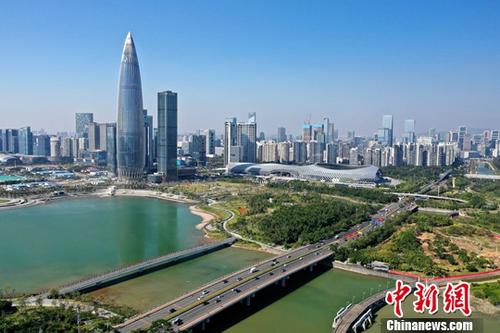Data map: Landscape of Shenzhen Bay Park and Talent Park.
China News Agency reporter Chen Wenshe
(The 100th Anniversary of the Communist Party of China) From the border town to the international city of Shenzhen, leading the Greater Bay Area
China News Service, Shenzhen, April 9th. Title: From the border town to the international city, Shenzhen leads the Greater Bay Area and departs again
Author Zhu Zuying
In the early 1980s, Shenzhen, adjacent to Hong Kong, was just a border town in southern China.
Over the past 40 years, the concept of the special economic zone has taken root and thrived here.
Growing from a border town to one of the top ten international cities in Asia, Shenzhen has not only become an economic sample of China's reform and opening up, but also an important engine in the process of building a world-class city cluster in the Guangdong-Hong Kong-Macao Greater Bay Area.
A reporter from China News Agency recently walked into the Shenzhen Party History Museum, which is full of records and objects from the rise of the Workers’ and Peasants Movement to the construction of reservoirs, to industrial development, and the first shot of China’s reform and opening up.
"In June 1979, the Guangdong Provincial Party Committee reported to the Central Committee the "Report on Taking Advantage of Guangdong's Advantages, Expanding Foreign Trade, and Accelerating Economic Development." The report pointed out that the three cities of Shenzhen, Zhuhai and Shantou will be piloted in export special zones. Overseas Chinese are allowed in the special zones. , Hong Kong and Macao businessmen directly invest in setting up factories, and certain foreign companies are also allowed to invest in setting up factories, or to establish joint ventures and tourism with them.” Mao Jianfeng, Director of the Party History Department of the Shenzhen Municipal History Office, said when talking about the establishment of special economic zones. .
On August 26, 1980, the Fifteenth Session of the Standing Committee of the Fifth National People's Congress made a decision to approve the establishment of special economic zones in Shenzhen, Zhuhai, Shantou, and Xiamen in Guangdong and Fujian provinces, and passed the Regulations on Special Economic Zones of Guangdong Province.
In Shenzhen Nanshan Shekou Time Square, the catchy phrase "time is money, efficiency is life" brings people back to the energetic era of reform and opening up.
As the highland of China's reform and opening up, Shekou, which was once full of wooden sheds and muddy roads, has now transformed into an international community full of tall buildings.
The Shenzhen Opera House, the first of Shenzhen’s “New Top Ten Cultural Facilities”, is here. Walking eastward along the square in the western section of the Shenzhen Bay Coastal Leisure Belt, passing by the Yuehai Square, overlooking the Shenzhen Bay Bridge, and the corridors along the way are full Industrial design style.
From the "Report on Taking Advantage of Guangdong's Advantages, Expanding Foreign Trade, and Accelerating Economic Development" to the "Regulations on Special Economic Zones of Guangdong Province", the special zone is regarded as a window for China's reform and opening up.
Mao Jianfeng said: "China can observe the external world's economic situation, science and technology, and market supply and demand development and changes through this'window', and introduce and learn from foreign advanced technology and management experience."
In 1979, Shekou introduced China's first foreign-invested company Zhonghong Oxygen Plant; in 1983, Sanyo Electric (Shekou) Co., Ltd. became China's first wholly-owned Japanese company.
At the time of reform and opening up, in just two years, Shekou became an export processing industrial zone with shipping industry as the main body and light industry, catering and tourism services as subsidiary industries.
Mao Jianfeng said that over the past 40 years of development, innovation is the biggest feature of Shenzhen.
"Shenzhen has created nearly a thousand'China's No. 1'and more than 120 world firsts."
Shenzhen’s reform and opening-up has gone from attracting Hong Kong capital to the globalization of sources of foreign investment, from “three to one supplement”, “front store and rear factory”, to a large number of enterprise products and even R&D institutions going global, from the establishment of the first in mainland China. The Export Processing Zone has maintained its No. 1 position among cities in mainland China in foreign trade for 25 consecutive years, and has cultivated 8 Fortune 500 companies.
40 years ago, Shekou Industrial Zone was a symbol of China's reform and opening up; 40 years later, innovative and entrepreneurial enterprises have sprung up in Qianhai, Shenzhen.
According to data from Shenzhen Qianhai Administration Bureau, as of the end of 2020, there were 11,300 registered Hong Kong-funded enterprises in Qianhai, and the actual use of Hong Kong capital for the whole year was US$3.802 billion.
Guo Wanda, executive vice president of the China (Shenzhen) Comprehensive Development Research Institute, said in an interview that Shenzhen's reform and opening up promote each other, and at the same time promote development through reform and opening up.
"Shenzhen's'special products' are enterprises. Through the policy of reform and opening up, Shenzhen has created a good business environment to attract more companies to settle here. World-renowned companies such as Huawei and BYD have also been born here."
Guo Wanda believes that globalization is an unstoppable trend, and Shenzhen still needs to continue its reform, opening up and innovation.
In Guo Wanda's eyes, Shenzhen is the core engine for the development of the Guangdong-Hong Kong-Macao Greater Bay Area.
He said: “Shenzhen plays the leading role of a comprehensive national science center and an international science and technology innovation center in terms of innovation and development. At the same time, Shenzhen’s urban rail, high-speed rail, airport, and port are all developing rapidly, integrating with the surrounding cities to achieve A one-hour living circle in the Guangdong-Hong Kong-Macao Greater Bay Area." (End)

